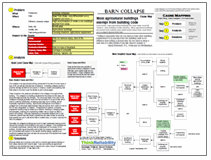By Kim Smiley
On July 17, 1981, the second and fourth floor suspended walkways collapsed at the newly opened Hyatt Regency of Kansas City, Missouri. A dance contest had attracted a crowd and the atrium under the walkway was filled with people. This accident killed 113 people and injured 186.
The hotel was newly constructed and the walkways were well maintained. So how did this happen?
 A root cause analysis of this accident shows that there were a number of causes that contributed to the walkways collapsing. Investigation into the accident shows that the structural design of the walkway was inadequate. A weld failed which allowed a support rod to pull through the box beam and the walkways fell.
A root cause analysis of this accident shows that there were a number of causes that contributed to the walkways collapsing. Investigation into the accident shows that the structural design of the walkway was inadequate. A weld failed which allowed a support rod to pull through the box beam and the walkways fell.
Additionally, the weld had greater stress than normal on it at the time of the failure because a large crowd had gathered to watch a danced content. About 20 people were on second floor walkway and about 40 were on the fourth floor walkway at the time of the accident. The higher loading combined to the walkway collapse.
Identifying the failure mechanism is important during an investigation, but a thorough root cause analysis needs to take the analysis farther to really understand the causes. The reason that an inadequate design was built needs to be determined.
In this case, it appears that the design was changed without approval of the structural engineer. This resulted from a communication error between the fabricator and the structural engineer. The structural engineer sent a sketch of a proposed walkway design to the fabricator, assuming that the fabricator would work the details of the design himself. The fabricator assumed the sketch was a finalized drawing. The fabricator then picked standard parts to fit the sketch. This resulted in a significant change from the original design and dramatically decreased the load bearing capacity of the walkways.
The original design called for continuous hanger rods (a non-standard part that would have needed to be manufactured) that passed through the fourth floor walkway beam box to the second floor walkway, resulting in the ceiling connecting supporting the weight of both walkways. The fabricator changed the design to use two shorter rods (standard parts) which resulted in the fourth floor walkway supporting the weight of the second floor walkway, which it wasn’t designed to handle.
It’s important to investigate beyond the point of inadequate design to learn what failed in the design process to prevent future accidents from occurring.









